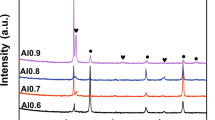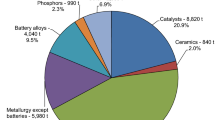We study Al3Sc, Al3Zr, Al3Hf, and Al3V intermetallic compounds playing the role of hardening phase in aluminum alloys. We use the technology of rapid crystallization from the liquid state. We obtain relatively fine grains d ∼ 15 μm in size for cast materials. By the method of X-ray diffraction analysis, it is shown that the Al3Zr intermetallic compound is a single-phase material, whereas the Al3Sc, Al3Hf, and Al3V intermetallics consist of several phases. The investigation of the mechanical characteristics by the indentation method shows that the Al3Hf intermetallic has the maximum hardness HV = 6.75 GPa and the maximum yield stress σSH = 4.86 GPa, whereas the Al3Sc intermetallic has the minimum hardness HV = 2.0 GPa, the minimum yield strength σSH = 0.86 GPa and the most plastic phase δH = 0.88. It is established that, in a 3% NaCl solution, the corrosion potentials (Ecorr) of the Al3Sc, Al3Hf, and Al3V compounds have close values ((– 0.52)–(– 0.57) V). In the potential range close to Ecorr, the dissolution rate of intermetallic phases in a 3% NaCl solution increases in the following order: Al3Sc < Al3Hf < Al3V. The role of intermetallic phase in the process of corrosion dissolution of aluminum alloy depends on its chemical composition, which determines the value of Ecorr in aggressive media. We prove that the anodic dissolution of an Al–3 wt.% Mg alloy doped with 0.3 wt.%. Sc in a 3% NaCl solution runs within the potential range more negative than the dissolution potential of the Al3Sc intermetallic compound. Thus, the intermetallic phases are cathodic inclusions relative to the matrix of the Al–Mg alloy that do not selectively dissolve under the corrosion conditions.






Similar content being viewed by others
References
M. E. Drits, L. S. Toropova, and Yu. G. Bykov, “On the mechanism of the influence of scandium on the increase in the strength and thermal stability of alloys of the Al–Mg system,” Dokl. Akad. Nauk. SSSR, 257, No. 2, 353–356 (1981).
V. I. Elagin, V. V. Zakharov, and Т. D. Rostova, “Aluminum alloys doped with scandium,” Metalloved. Term. Obrab. Splav., No. 1, 24–29 (1992).
V. G. Davydov, V. I. Elagin, V. V. Zakharov, and Т. D. Rostova, “Alloying aluminum alloys with scandium and zirconium additives,” Tsvetn. Met. Splav., No. 8, 25–30 (1996); English translation: Met. Sci. Heat Treat., 38, 347–352 (1996); https://doi.org/10.1007/BF01395323.
M. Hansen and K. Anderko, Constitution of Binary Alloys, McGraw-Hill, New York (1958).
Yu. V. Milman, S. I. Chugunova, I. V. Goncharova, and A. A. Golubenko, “Plasticity of materials determined by the indentation method,” Prog. Phys. Met., 19, No. 3, 271–306 (2018); https://doi.org/10.15407/ufm.19.03.271.
Yu. V. Milman, D. B. Miracle, S. I. Chugunova, I. V. Voskoboinik, N. P. Korzhova, T. N. Legkaya, and Yu. N. Podrezov, “Mechanical behavior of Al3Ti intermetallic and Ll2 phases on its basis,” Intermetallics, 9, 839–845 (2001); https://doi.org/10.1016/S0966-9795(01)00073-5.
D. Tabor, The Hardness of Metals, Clarendon Press, Oxford (1951).
M. Jahnátek, M. Krajčí, and J. Hafner, “Interatomic bonding, elastic properties, and ideal strength of transition metal aluminides: A case study for Al3(V,Ti),” Phys. Rev., B71, 024101 (2005).
Z. Chen, P. Zhang, and D. Chen, “First-principles investigation of thermodynamic, elastic and electronic properties of Al3V and Al3Nb intermetallics under pressures,” J. Appl. Phys., 117, 085904 (2015).
А. М. Sukhotin (editor), Handbook on Electrochemistry [in Russian], Khimiya, Leningrad (1981).
Author information
Authors and Affiliations
Corresponding author
Additional information
Yu. V. Milman is deceased.
Translated from Fizyko-Khimichna Mekhanika Materialiv, Vol. 58, No. 1, pp. 22–28, January–February, 2022.
Rights and permissions
Springer Nature or its licensor (e.g. a society or other partner) holds exclusive rights to this article under a publishing agreement with the author(s) or other rightsholder(s); author self-archiving of the accepted manuscript version of this article is solely governed by the terms of such publishing agreement and applicable law.
About this article
Cite this article
Shcherbakova, L.G., Milman, Y.V., Iefimov, М.A. et al. Mechanical and Corrosion Properties of Intermetallics Based on Aluminum. Mater Sci 58, 20–27 (2022). https://doi.org/10.1007/s11003-022-00625-7
Received:
Published:
Issue Date:
DOI: https://doi.org/10.1007/s11003-022-00625-7




